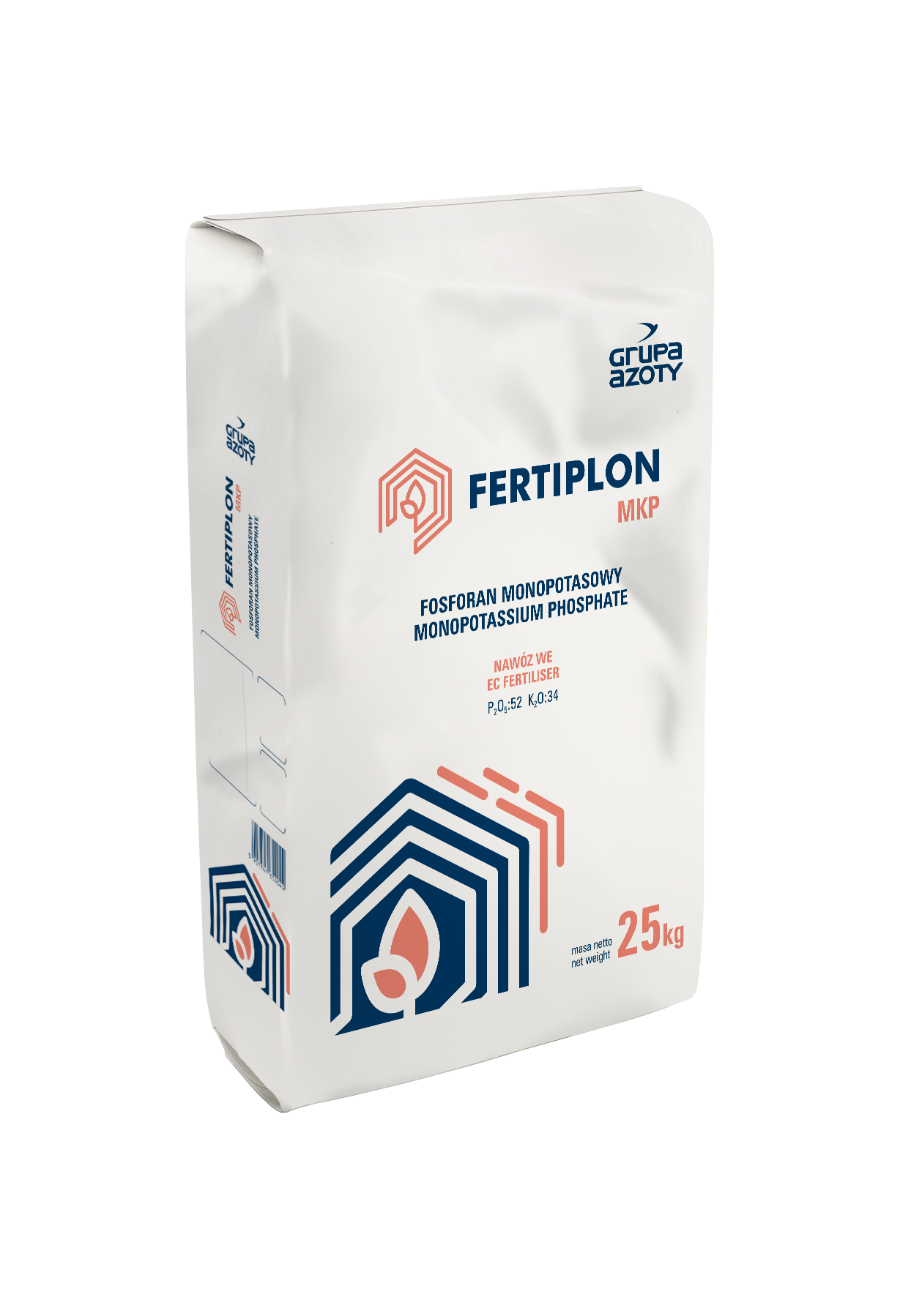
FERTIPLON MKP Monopotassium phosphate is a high-quality fine-crystalline loose, fully water-soluble two-component phosphorus-potassium fertilizer. Especially recommended during the early stage of plant growth, particularly in the event of reduced demand for nitrogen. Monopotassium phosphate is recomended for fertigation and foliar feeding of horticultural, fruit and agricultural crops both under covers and in the field. It can be used as a phosphorus and potassium fertilizer for direct application. In addition, it is recommended for the preparation of solid multi-component fertilizer mixtures and liquid fertilizers. A high content of potassium in FERTIPLON MKP has impact of the size and quality of crops as well as the resistance of plants to stress. A high phosphorus content in FERTIPLON MKP affects the proper development of the root system and plant development.
| Nutrients | % (m/m) |
| Main ingredient (KH2PO4) | At least 99.0 |
| Phosphorus pentoxide (P2O5) | At least 51.5 |
| Potassium oxide (K2O) | At least 34.0 |
| Moisture (H2O) | No more than 0.2 |
Packaging

Storage



| Crop | Application time | Application rate (kg/ha) | Recommended number of applications | Recommended quantity of spray liquid (L/ha) |
| Solanaceous vegetables: tomato, pepper | Fruit development (BBCH 71 – 79) | 0.6 – 1.5 | 1 | 300 – 500 |
| Ripening of seeds and fruits (BBCH 81 – 89) | 0.6 – 1.5 | 1 | 300 – 500 | |
| Cucurbits: pumpkin, cucumber, zucchini | Fruit development (BBCH 71 – 79) | 0.6 – 1.5 | 1 | 300 – 500 |
| Ripening of seeds and fruits (BBCH 81 – 89) | 0.6 – 1.5 | 1 | 300 – 500 | |
| Bulb vegetables: onion, leek | Development of harvestable vegetative plant parts – Bulb reaches 50% of typical diameter (BBCH 41 – 45) | 0.6 – 1.5 | 1 | 300 – 500 |
| Bulb reaches 60% of typical diameter – leaves dead (BBCH 46 – 49) | 0.6 – 1.5 | 1 | 300 – 500 | |
| Root vegetables: carrot, parsley, celery, beetroot | Roots beginning to expand – root reaches approx. 50% of typical diameter (BBCH 41 – 45) | 0.6 – 1.5 | 1 | 300 – 500 |
| Root reaches approx. 60% of typical diameter – typical form and size of roots reached (BBCH 46 – 49) | 0.6 – 1.5 | 1 | 300 – 500 | |
| Leafy vegetables: head cabbage, savoy cabbage, cauliflower, broccoli | Heads begin to form – head reaches 50% of typical size (BBCH 41 – 45) | 0.6 – 1.5 | 1 | 300 – 500 |
| Head reaches 60% of typical size – typical size, form and firmness of heads reached (BBCH 46 – 49) | 0.6 – 1.5 | 1 | 300 – 500 | |
| Legumes: peas, beans | Inflorescence emergence (BBCH 51 – 59) | 0.6 – 1.5 | 1 | 300 – 500 |
| Fruit development (BBCH 71 – 79) | 0.6 – 1.5 | 1 | 300 – 500 | |
| Pome-fruit trees: apple tree, pear tree | Fruit diameter up to 40 mm – fruit about 90% final size (BBCH 74 – 79) | 1 – 2.4 | 1 – 2 | 500 – 800 |
| Beginning of ripening – advanced ripening (BBCH 81 – 85) | 1 – 2.4 | 1 | 500 – 800 | |
| Stone-fruit trees: sour cherry, cherry | White bud – (BBCH 57 – 59) | 1 – 2.4 | 1 – 2 | 500 – 800 |
| Fruit development (BBCH 72 – 79) | 1 – 2.4 | 1 | 500 – 800 | |
| Berry plants: strawberry, currant, blueberry | Leaf development (BBCH 15 – 19) | 0.6 – 1.5 | 1 – 2 | 300 – 500 |
| Fruit development (BBCH 71 – 79) | 0.6 – 1.5 | 1 | 300 – 500 | |
| Agricultural crops | ||||
| Cereals | 4 – 8 leaves unfolded (BBCH 14 – 18) | 0.4 – 0.9 | 1 | 200 – 300 |
| Maize | 4 – 6 leaves unfolded (BBCH 14 – 16) | 0.4 – 0.9 | 1 | 200 – 300 |
| Oilseed rape | 4 – 8 leaves unfolded (BBCH 14 – 18) | 0.4 – 0.9 | 1 | 200 – 300 |
| Beginning of main stem elongation (BBCH 30 – 31) | 0.4 – 0.9 | 1 | 200 – 300 | |
| Sugar beet | 4 – 6 leaves unfolded (BBCH 14 – 16) | 0.4 – 0.9 | 1 | 200 – 300 |
